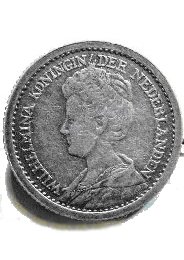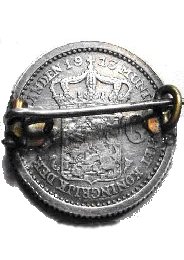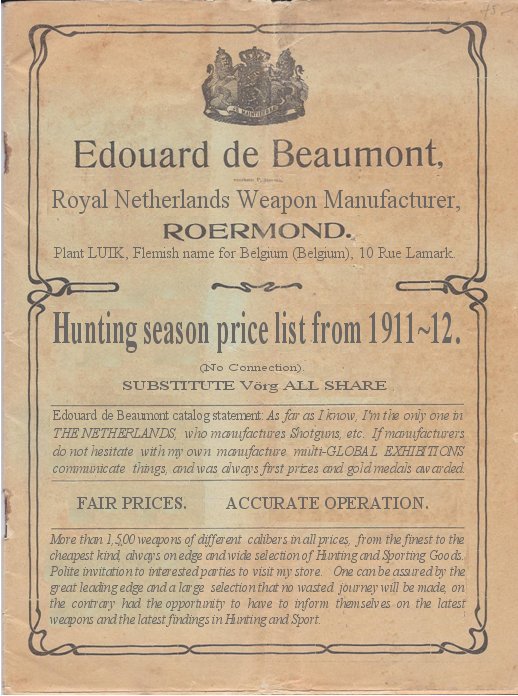buttons



WILHELMINA KONINGEN DER NEDERLANDEN
Featured is a very rare, never pictured or published, 1911 – 12, seventy-five page Netherlands Hunting and Sports commercial sales catalog of Edouard de Beaumont titled: Prijscourant Jachtseizoen 1911 - 12. The Lugers advertised in this catalog on page 27 for the Luger pistol and page 29 for the Luger carbine are of new DWM manufacture and not used excess. Although the manufacture Edouard de Beaumont is described as a Royal Netherlands Weapons Manufacturer on the cover page, it is misleading. The K or Koninklijk, meaning Royal, was added later. The army’s name was still the NIL and not yet the KNIL, as indicated in this 1911-12 sales catalog Luger pistol ad.

The firm of Edouard de Beaumont was the biggest gun dealer in Holland at that time. Beaumont made deliveries of guns and ammunition to all kinds of government departments. In this catalog, police guns are also offered in that way. The subject Beaumont catalog states that they will sell the same Luger model (M11) as used in the Dutch East Indies Army or NIL. Although in 1911-12 the Dutch had several Luger models, they continued to use a picture of an old model Luger. They may not yet have had a picture of the M11 (K) NIL Luger. Also, many period commercial weapons sales catalogs, right up to World War I, although selling new model Lugers, pictured old model production Lugers. Several catalogs even showed the 1899 Borchardt-Luger, meaning that they never bothered to update their file pictures.
The Luger pistol description of PARABELLUM Netherlands Indies Government’s model cal 9mm is correct, even though the model M11 is not stated in the ad, the 1906 (K) NIL M11 model, however, had certain features, such as a grip safety and Geladen (Loaded) stamped on both sides of the extractor, RUST in the Thumb Safety area, etc. It is important to remember that the officers in the NIL did not get a pistol from the army but had to buy their own pistol and uniform etc., so Beaumont is offering the Dutch NIL model for these officers that had to buy a personal pistol along with a spare magazine, accessories, and a Sterk bruin leder foudraal (Ordonnonans model) met reim or Strong brown leather holster (Ordnance model) with belt.[1]
As 1911 is the official Dutch government contract acceptance date for the 9mm Dutch Luger, hence the Model 11 or M11 designation, it is interesting that, apparently, the subject 1911-12 Beaumont hunting catalog is not the first Beaumont hunting catalog to advertise the Dutch “M11”, as an almost identically worded ad appeared two years earlier in the 1909-10 Beaumont catalog. This information is documented and the ad is pictured in an article on Dutch Lugers, authored by the late Dick Deibel, a noted Dutch Luger collector and expert, in a January 1974 British publication entitled “guns review” with the following text caption and text description.
In an old price list we find Parabellum pistols advertised (see Fig 6) showing that the German-Dutch flirtations did not proceed without difficulties. This price list was distributed by a firm in Roermond for the hunting season 1909-10. “Edouard de Beaumont, Royal Netherlands arms manufacture” advertises the 7.65 mm. Parabellum here for 49.75 Dutch Guilders. Underneath the advertisement we find a typical remark that could be actually timeless: Netherlands Government Model 9mm. f50 – N.B. This model has been adopted by the Netherlands Army and would have been issued already if Parliament had not refused the funds”. Again in other (1911/1912) Beaumont contemporary price list we find this 9mm. model called the “Dutch model” – and all that for just one quarter of a Guilder more!
Deibel, in his 1974 article is referring to the price difference in the Fig 6 ad of f49.75 Dutch Guilders for the pictured 30 cal old model Luger vs. the f50 Dutch Guilders price for the Netherlands government Ordinance model or M11. It is interesting to note that the earlier Fig 6 1909-10 Beaumont ad, pictured in the 1974 Deibel article, describes the M11 as the Netherlands Government “Ordinance” Model whereas in the (two hunting seasons) later issue of the subject 1911-12 Beaumont catalog ad, expands the description to Netherlands Indies Government “Ordinance model”. The 1911-12 price for the 30 cal Luger has been reduced to f40 Dutch Guilders whereas the “M11” stays at f50. The word “ordinance” is added to the description based on the leder foudral or holster description of Ordonnans model used in both ads. Also interesting in the 1909-10 Beaumont ad description of the 7.65 mm old model Luger references only the Swiss adoption of the 7.65 m Luger whereas the subject 1911-12 ad expands the description to include: The German armies and others armed with this repeating pistol, while the Netherlands Government shall also import for the Netherlands Indies Army.
With the first contract being signed on May, 1911 and with the first, final design Lugers, with all the well recognized M11 features incorporated, not being delivered until early 1912[2], it is unusual that Beaumont would be offering these pistols as early as 1909-10. Especially since any M11 being sold to officers by Beaumont would surely have the crown Wilhelmina acceptance stamp, which appears to be applied by DWM in the white prior to bluing vs. being applied by the Dutch government at receipt, as no examples show “frosting”, a result of being stamped after the bluing process. Since, indeed the 1909-10 Beaumont sales catalog does, as interpreted, offer the M11 for sale, Beaumont could have had earlier small order deliveries of these crown W acceptance stamped guns from DWM, with the approval of the Dutch government or possibly he was taking orders in anticipation of delivery.
The Beaumont ad and other period sales catalogs of the time, in general, could have been all exaggerations as in the opinion of a major European Luger collector and author: They are all full of hyperbole, let alone mis-designations, so one has to look through what they advertise to the underlying fact - and relating specifically to the Beaumont claim in the subject 1911-12 catalog ad to be selling the Dutch M11 or the “Netherlands Indies Government cal 9mm Model” to officers, are the following additional comments by the same European authority - these are simple commercial offerings of the Parabellum, as Beaumont was the DWM agent for the Netherlands for all importations, civilian and military contract. The earlier 1909-10 offering is for the commercial New Model, while the later offering is for the same gun, but they used Indies adoption to boost the status of the gun in 1911-12. The Dutch (home) Army never seriously intended adopting the Parabellum, and all Indies Army officers were issued with their pistols, not given the option of private purchase.
Then, of course, statements contrary to the above conclusions or opinions are made in The Dutch Luger book on page 74, under the title of Adaption and Use, 1910 – 1914 when discussing the disposition of certain quantities of the first DWM contract deliveries of M11 Lugers is the following statement: After negotiations with DWM about the desired specifications, a first contract for the purchase of 1,391 M11 pistols was signed in May, 1911. Of these, 750 were meant as a replacement for the army revolver, 500 were destined to be sold to officers... Since the 1911-12 Beaumont catalog ad is quite specific, no ambiguities whatsoever, when he describes in (the ad) that he is selling the Netherlands Indies Government cal 9mm Model for f50. Also Deibel seems to come to the same conclusion in his 1974 article. Since Deibel’s knowledge or expertise in the history of Dutch Lugers is an established fact, specifically, there is no doubt in his ability to read, speak and translate Dutch regarding his translation/interpretation of the ad as described in the Fig. 6 text caption. Why then would Beaumont make such a specific claim (lie or misrepresentation) offering the “government cal 9mm for f50” is unclear, although Deibel seems to contradict himself or more exactly Beaumont does when, as Deibel says, when quoting the Beaumont comment in the 1909-11 catalog ad offering the M11 for sale that Beaumont concurrently stated that: there were no issued M11 Lugers as of 1909-10.
Edouard de Beaumont vs. Georges & de Watteville
Even though early on, the firm of Edouard de Beaumont was, apparently, one of the manufacturers of the Dutch Army “1891 revolver”, as to why the firm was chosen or became a “sole” supplier for Dutch army officers of the M11 in the first place is somewhat mysterious, as from the beginning of the initial contract negotiations, the Dutch representative or intermediary for DWM was the firm of GEORGES & DE WATTEVILLE, which was also a long time dealer based in Amsterdam, which was the DWM intermediary who interfaced with the Dutch government. In fact the firm of Georges & de Watteville was involved from the beginning with the acquisition and subsequent Dutch testing of a DWM C93 Borchardt in 1895, to the contract negotiations for the aborted June 1914 400 M11 pistol delivery, and later as the DWM representative between Vickers Ltd and the Dutch government in the immediate post World War 1 era, resulting in the recognition or introduction of Vickers Ltd of England as yet another Luger manufacturer.
Unfortunately, except for the ink stamped Georges & de Watteville logo stamped in a rare DWM C93 German language owner’s manual, no period brochures or sales catalogs of the company or firm, if any, have surfaced, so the claim of Edoard de Beaumont as a “pre-contract” M11 distributor or supplier, as attested by the surviving subject 1910-11 sales brochure, stands.
1911 – 12 Beaumont ad dealing with accessories.

Mouse over ad for English translation.
Shown below is a rough translation of the catalog cover.

As to the currency used in The Netherlands in 1912 and in the subject catalog, the lower case f, followed by the monetary amount means Florins, which was a much older currency of Holland, which was also used for the Gulden (Dutch Guilder). So in 1912 it was Gulden, therefore the fis for Gulden.
There is a Beaumont “catalog” page pictured in Luger Holsters and Their Accessories of the 20th Century by E bender, page 426, stated to once belonging to Edouard de Beaumont with the following caption: Page once belonging to Eduard De Beaumont, one time Royal Dutch firearms manufacturer and dealer. The sheet features a variety of automatic repeater carbines.
Firstly, the caption misspells Eduard De Beaumont, which should be Edouard de Beaumont and the claim of the page being a stand-alone sheet, rather than a page cut-out of a catalog is a bit dubious, as the lower part of the sheet is truncated or cropped where the page number is placed in the original catalogs. The most curious aspect of this “single sheet” page when compared against the similar page 29 of the subject catalog is the slightly different layout and, specifically, the accompanying text description of the “Parabellum Repeeter Karabijn” or 1902 Luger Carbine.[3]
Per a conversation with a Dutch speaking collector in The Netherlands, the word or expression Zie hiervoren (See above) in the subject 1911-12 catalog is an earlier pre-1912 spelling whereas Zie hiervoor (See above), as shown in the single Beaumont sales catalog page, pictured in Bender’s book on page 126 is a post-1912 spelling. Yet the older, pre 1912 spelling of ammunitie is used in the newer or later single page post 1912 Beaumont ad. The only thing that could account for these Dutch language inconsistencies is in the use of a different printer house and personal choice or preference of spelling, therefore, cannot be used to chronologically date or determine which document was printed first. The Dutch language spelling changes, apparently occurred in the same time frame with the German language, however, the well documented changes for the German language came as a result of the 1901 German National Orthographic Conference, where a lot of spelling changes and meanings took place.
The statistics or specifications, and the spelling andarrangement are different for each ad with the subject page 29 Luger carbine ad stating the weight, which is incorrect, to be 1800 Gram for a lower price of f 110, . The “single-sheet” ad states a correct weight of 1700 Gram and a higher price of f 115, and also includes in the text description the added word ammunitie. Both ads conclude with the translated statement in closed parentheses (See above) but with different Dutch spellings of (Zie hiervoren) vs. (Zie hiervoor). The (See above) statement on page 29 of the subject catalog is referring to the Luger pistol description; however, the Luger pistol is on page 27 of the subject catalog, indicating that at one time, the Luger pistol and carbine ad were on the same page. Regarding the difference in price, it is impossible to conclude which ad came first, although with the discovery of the 1909-10 print date Beaumont ad discussed earlier, it is the price, not the language differences, in this instance, that determine the date of printing, with price reductions in the later 1911-12 identical Beaumont ads. The incorrect weight of 1800 Grams can be attributed to a typo, although in the original DWM German language 4-page flier for the “new carbine” stated the weight of the carbine to be approximately 1700 grams. The different spelling of the word “See above” in (See above) is, most likely, a grammatical choice of the print house. The reason for the added word ammunitie is merely semantics or can be attributed to an expanded description.
Prijscourant Jachtseizoen 1911- 12 catalog, page 29, 1902 Luger carbine description

Rough translation
“Walk” length 30 c.M. (possibly length of barrel) of the whole
rifle length 74 c M.
Weight 1800 Grams f 110,--
Same caliber and treatment
as the Parabellum gun.
(See above).
Luger Holsters and Their Accessories of the 20th Century, page 426, single sheet Luger carbine description

Rough translation
“Walk” Length 30 c.M. (possibly length of barrel). The whole
length 74 Carbine c.M.
Weight 1700 Grams f 115,--
Same caliber, ammunition, and
treatment as the Parabellum
gun. (See above).
Summary and conclusions
Unfortunately, except for the ink stamped Georges & de Watteville logo stamped in a rare DWM C93 German language owner’s manual, no period brochures or sales catalogs of the company or firm, if any, have surfaced, so the claim of Edoard de Beaumont as a "pre-contract" M.11 distributor or supplier, as attested by the surviving subject 1910-11 sales brochure, stands. There are however other period Dutch firms advertising the Automatische Parabellum Pistool. Pictured in Luger Holsters and Their Accessories by E. Bender on page 432 is a Dutch arms manufacturer, Marius Micheel, which features in a1911 catalog a Luger ad with text referring to the Kal. 7.65 or 9mM Ned. Gouvern-Model, however, picturing and old file copy hand held old model 30 cal Luger, therefore is inconclusive as to whether the firm is offering the Dutch military M.11 or commercial version of the P.08.
It is a 1912 Mansvelt & Son ad for the Automatische Parabellum Pistool that is the most convincing case, erring toward a commercial offering of the P.08. The ad description has the typical text caption:
The automatic pistol „Parabellum”, 9 mm caliber is one of the high demands of present-day weaponry completely satisfying fist weapon. Because of simple construction, reliability and excellence and outstanding results was accepted in various armies and now also introduced in the Dutch East Ind. Army.
This P. Mansvelt & Son 1912 ad leaves little doubt as to what 9mm Luger version was being offered as the ad pictures a classic, no grip safety P.08 with a Gesichert stamp, clearly visible in the thumb safety area with the caption: Automatische Pistolen PARABELLUM. - Ned. Gouvernments Model. Although, this ad, which is also pictured in Luger Holsters and Their Accessories by E. Bender on page 428 with the following caption: Page 34 features the Netherlands’ government model Parabellum that misleadingly interprets the ad to be offering the M11 Dutch Army version.
It can be concluded from the above ad that all period indigenous Netherlands Dutch weapons manufacturer’s hunting and sales catalogs, when advertising the 9mm Luger, were offering the commercial version of the P.08, and were using the recent adoption of the Dutch M.11 for the KNIL or Dutch East Indies Army (not the home army), solely as a promotional tool to sell the commercial P.08, in The Netherlands home country only, and not the Dutch East Indies Colonies. As to whether KNIL officers were required/allowed to purchase their M11 Lugers is unclear, what is clear, however, is that they did not purchase them from any of the Dutch merchants featured in this article. What is known regarding the first contract deliveries of the Dutch M11 Luger from DWM is that they went to the Indies Colonial Office in Den Haag, Holland for onward shipment to the KNIL or Dutch East Indies Colonies where, one has to assume, some were issued (sold) to officers and the bulk of the deliveries were eventually distributed or issued to regular army.
 Home page
Home page

